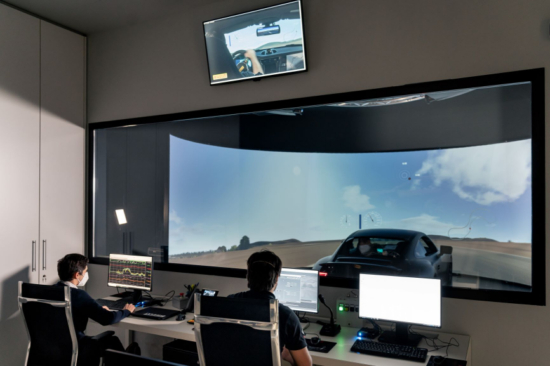Pirelli extends tyre tech research partnership
 The extended partnership utilises the static simulator at Pirelli’s R&D centre in Milan (Photo: Pirelli)
The extended partnership utilises the static simulator at Pirelli’s R&D centre in Milan (Photo: Pirelli)
A decade after the first agreement, Pirelli, Milan Polytechnic and Polytechnic Foundation have signed off a three-year continuation of their ‘Joint Labs’ programme, which centres upon research projects that advance tyre-related technological innovation.
The extended partnership will utilise the static simulator at Pirelli’s R&D centre in Milan as well as the Politecnico’s dynamic simulator, and in addition to enhancing the potential of virtual modelling, this latest chapter of the two-million-euro agreement focuses on two main areas of research: materials and product/cyber development. The first of these involves the development of innovative solutions and modelling of mixing processes, while the second consists of integrated static or dynamic simulation and innovative modelling.
The engine room
“Innovation is the engine room of our company,” states Marco Tronchetti Provera, Pirelli’s executive vice-chairman and chief executive officer. “Being able to rely on a network including the most advanced research institutions and universities in the world, such as Milan University, means investing to meet the future challenges of mobility.
“Our priorities with the ‘Joint Labs’ programme take in all aspects of sustainability, evolved automation, virtualisation and connectivity, The collaboration with the University underlines our commitment to strengthen the core of our group’s know-how in these key areas within Italy.”
University involvement
Five departments of Milan University – mechanics, chemistry, materials and chemical engineering, mathematics, electronics, information and bioengineering, and civil and environmental engineering – participate in this agreement, and researchers take part in the following areas:
Simulation: integrated use of static and dynamic simulators with the aim of optimising the development and testing of new tyres, reducing lead times and strengthening collaborations with car manufacturers.
Materials: modification of polymers, nanofillers, protective tyre materials, new materials with low environmental impact; open-source modelling for mixing and modelling of textile reinforcements.
Product and cyber development: external and internal noise, tyre aerodynamics, automated tread modelling; development and consolidation of models for intelligent vehicle control data, and development of value-added services from the cyber system.
Joint commitment to research & training
Over the ten years of the collaboration between Milan University, the University Foundation, and Pirelli, no fewer than 14 registered patent families have been filed and about 30 articles published in international scientific journals, as well as a number of high-profile presentations made at international conferences. Multiple topics have been addressed and the advanced materials identified through this partnership have resulted in enhanced tyre performance, safety and sustainability.
In particular, 15 research grants for young graduates were awarded in the materials chemistry sector. In the last three years, research has mainly focused on the production and functionality of carbon allotropes, preparation of modified silica fibres, as well as studies into alternative sources of natural rubber, synthesis of innovative polymers, and self-repairing materials. In the tyre mechanics sector, 12 research contracts have been activated in the cyber tyre and Formula 1 fields since 2011, with study into the interaction between tyres and asphalt.
An area of particular interest is the study of low-noise tyres for new hybrid and electric vehicles, a key aspect of driver comfort. Researchers apply innovative testing methods to measure indoors the acoustic field generated by the rolling tyre. Using the Tread Modelling Automation project, the modelling of the tyres and the characteristics of the different summer, winter and all-season tread patterns were studied.
Specialised engineering programme
Supporting professional training, Pirelli also recently inaugurated the “R&D Excellence Next” postgraduate university Master’s degree in collaboration with Milan Polytechnic. This programme involves the specialist training of 34 newly hired Pirelli engineers. Pirelli considers it an evolution of the careers that several researchers and doctoral students have enjoyed within the company in areas such as innovative materials, modelling and cyber, which has contributed to the success of these joint projects over the last ten years.
150 years of history
The relationship with Milan Polytechnic dates back to the very beginning of Pirelli’s history. In 1870, recent graduate Giovanni Battista Pirelli was directed by his teacher, Giuseppe Colombo, towards the chemical industry and rubber production. Giovanni Battista Pirelli became the father of this industry in Italy, founding his company, Pirelli & C, in 1872.
Over the years, Milan University and Pirelli have collaborated on numerous occasions in order to capitalise on the synergies between the academic and business worlds. One of these projects from the past was CORECOM (Consorzio Ricerche Elaborazione Commutazione Ottica Milano) from 1995. This was among the first associations between the public and private sectors in Italy and was a leading player in the development of international photonics until 2010.
“The Joint Lab underlines the importance of this long standing and constructive relationship between university and company,” comments Ferruccio Rest, dean of Milan Polytechnic. “Research and training are the prerequisites for an industrial development that looks to the future. The agreement between the Politecnico di Milano and Pirelli is solid and this is the direction we wish to pursue.”
“Pirelli, as well as participating in our birth, was one of the first companies to believe in the Foundation’s ability to create synergies in the region, to enhance the scientific research done by the Milan Polytechnic,” adds Andrea Sianesi, chairman of Milan Polytechnic Foundation. “Today we are talking about sustainable mobility: this agreement aims to consolidate enduring relationships for investments in the long term, which will enable the realisation of advanced research with a high level of experimental and innovative content. Strategic partnerships like this create constant dialogue between companies and the university in order to shares needs, strategies and visions.”


 Halfords
Halfords
Comments